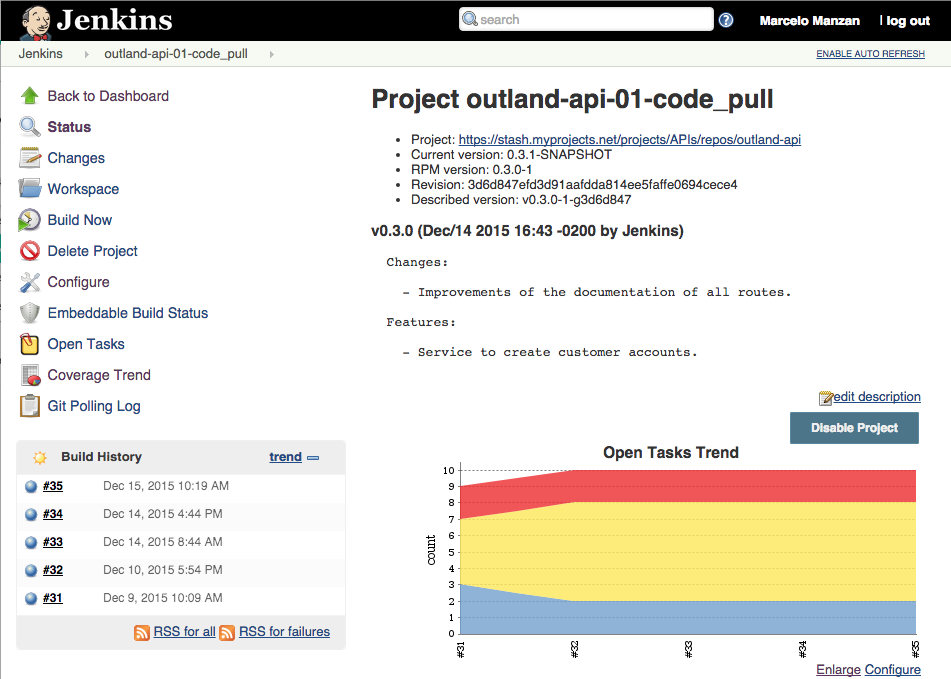
StepUp is a tool to manage versioning. That means you can bump the version of your project, for example, from v3.0.11 to v4.0.0, check the current version, summarize all the history of versions in a changelog and more.
StepUp is based on source control management features (i.e. tags, branches, commits, notes etc), so it doesn't need to keep files with the current version, it has visibility of all history of changes and versions (doesn't matter if they are spread in many different branches), which adds a variety of possibilities in terms of management, depending on your project needs.
- Allow you to attach notes to existing commits to mark fixes or new features that are being delivered.
- Organize notes into sections of bugfixes, features, minor changes and so on.
- View release notes for the next version of the project that will be boosted.
- Auto-increment the version of the project based in the release notes (according to semver.org guidelines).
$ gem install step-upRun the following command into your project's root folder:
$ stepup [version]An example of output would be
v0.2.0+3
Consider that your project has a tag named "v0.2.0". The "+3" part of the output above means the project has three commits since last version tag. The format of the version is totally customizable, and we will cover in more detail later.
stepup version create [--level LEVEL_NAME]
where LEVEL_NAME, by default, could be
- major
- minor
- patch
- tiny
This command will increment the version number according with the specified level.
Each level corresponds to a position in the version mask. Considering default settings, this means:
v0.0.0.9 => vMAJOR.MINOR.PATCH.TINY
The versioning increment is based on the last version tag found in the repository, and works as follows:
v0.5.3.2 => v0.5.3.3 (TINY increment)
v0.5.3.2 => v0.5.4 (PATCH increment)
v0.5.3.2 => v0.6.0 (MINOR increment)
v0.5.3.2 => v1.0.0 (MAJOR increment)
As you can see, the TINY level is omitted when its value is zero. The mask allows you to configure the less relevant levels this way.
Note:
In order to maintain the convention indicated by the semver.org, the TINY level will be deprecated in future releases.
stepup changelog [--top=N]
With StepUp we are able to attach additional comments on existing commit objects. The great goal of this Gem is giving to developers an easy way to manage these notes.
The note is created with a command as the example below:
$ stepup notes add --section bugfixes -m "support for old installations"
It's possible to use the same command with no paramenters. This way an wizard will guide through the process. Still with this example we can check the created note with the following command:
$ stepup notes
---
Bugfixes:
- support for old installations
The command above fetches the entire commit history, gets each note and organizes them in sections. Found notes are displayed as a changelog message.
With a culture of notating all the relevant developments, its possible to retrieve a summary of a range of versions besides that specifying what kind of information will be retrieved. For example, imagine that you want to see all the features implemented in your application since the version v1.10.1 up to v2.0.0
stepup notes --since v1.10.1 --upto v2.0.0 --sections pre_deploy pos_deploy
The result would be something like the following:
Showing notes since v1.10.1 up to v2.0.0 (including notes of tags: v1.10.1, v1.10.2, v1.51.0, v2.0.0)
---
Pre-Deploy:
- dependency of version v10 of project XYZ
- it needed to rename the following file
- config/environment_variables.yml.sample -> config/environment_variables.yml
- rake articles:index
Pos-Deploy:
- Reindex articles
- rake articles:index
- rake db:seed
- rake categories:reload
You can use the stepup commands to extract information of your project and display them on Continuous Integration tools.
- Fork it
- Create your feature branch (
git checkout -b my-new-feature) - Commit your changes (
git commit -am 'Added some feature') - Push to the branch (
git push origin my-new-feature) - Create new Pull Request

